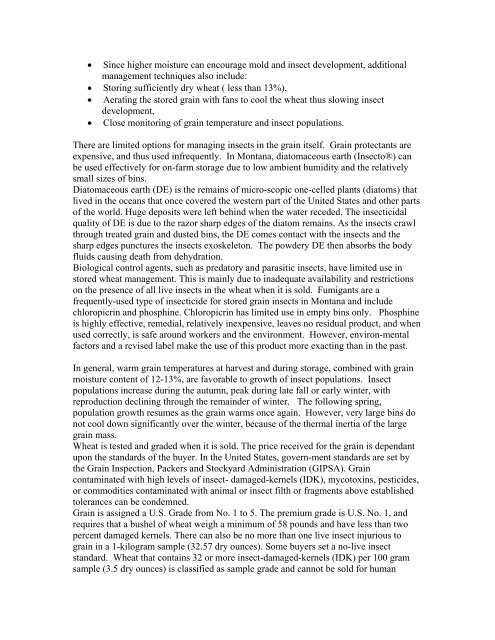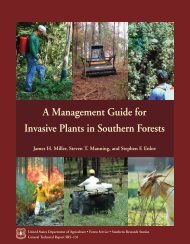Introduction - Stored Grain Pest Management Pest Management for ...
Introduction - Stored Grain Pest Management Pest Management for ...
Introduction - Stored Grain Pest Management Pest Management for ...
Create successful ePaper yourself
Turn your PDF publications into a flip-book with our unique Google optimized e-Paper software.
• Since higher moisture can encourage mold and insect development, additionalmanagement techniques also include:• Storing sufficiently dry wheat ( less than 13%),• Aerating the stored grain with fans to cool the wheat thus slowing insectdevelopment,• Close monitoring of grain temperature and insect populations.There are limited options <strong>for</strong> managing insects in the grain itself. <strong>Grain</strong> protectants areexpensive, and thus used infrequently. In Montana, diatomaceous earth (Insecto®) canbe used effectively <strong>for</strong> on-farm storage due to low ambient humidity and the relativelysmall sizes of bins.Diatomaceous earth (DE) is the remains of micro-scopic one-celled plants (diatoms) thatlived in the oceans that once covered the western part of the United States and other partsof the world. Huge deposits were left behind when the water receded. The insecticidalquality of DE is due to the razor sharp edges of the diatom remains. As the insects crawlthrough treated grain and dusted bins, the DE comes contact with the insects and thesharp edges punctures the insects exoskeleton. The powdery DE then absorbs the bodyfluids causing death from dehydration.Biological control agents, such as predatory and parasitic insects, have limited use instored wheat management. This is mainly due to inadequate availability and restrictionson the presence of all live insects in the wheat when it is sold. Fumigants are afrequently-used type of insecticide <strong>for</strong> stored grain insects in Montana and includechloropicrin and phosphine. Chloropicrin has limited use in empty bins only. Phosphineis highly effective, remedial, relatively inexpensive, leaves no residual product, and whenused correctly, is safe around workers and the environment. However, environ-mentalfactors and a revised label make the use of this product more exacting than in the past.In general, warm grain temperatures at harvest and during storage, combined with grainmoisture content of 12-13%, are favorable to growth of insect populations. Insectpopulations increase during the autumn, peak during late fall or early winter, withreproduction declining through the remainder of winter. The following spring,population growth resumes as the grain warms once again. However, very large bins donot cool down significantly over the winter, because of the thermal inertia of the largegrain mass.Wheat is tested and graded when it is sold. The price received <strong>for</strong> the grain is dependantupon the standards of the buyer. In the United States, govern-ment standards are set bythe <strong>Grain</strong> Inspection, Packers and Stockyard Administration (GIPSA). <strong>Grain</strong>contaminated with high levels of insect- damaged-kernels (IDK), mycotoxins, pesticides,or commodities contaminated with animal or insect filth or fragments above establishedtolerances can be condemned.<strong>Grain</strong> is assigned a U.S. Grade from No. 1 to 5. The premium grade is U.S. No. 1, andrequires that a bushel of wheat weigh a minimum of 58 pounds and have less than twopercent damaged kernels. There can also be no more than one live insect injurious tograin in a 1-kilogram sample (32.57 dry ounces). Some buyers set a no-live insectstandard. Wheat that contains 32 or more insect-damaged-kernels (IDK) per 100 gramsample (3.5 dry ounces) is classified as sample grade and cannot be sold <strong>for</strong> human
















